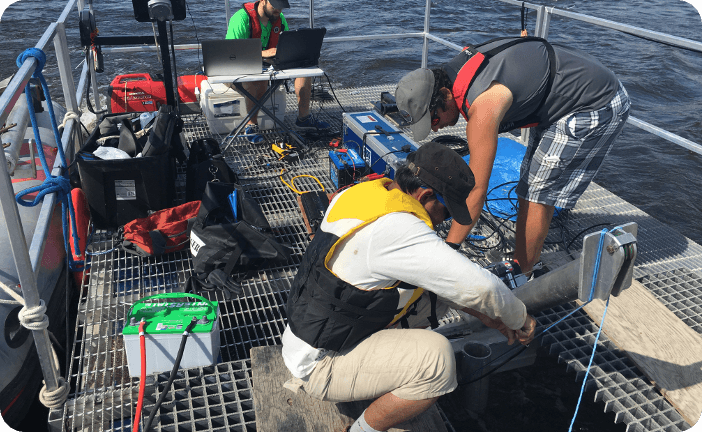Lead Proponent: University of Manitoba
Location: Winnipeg, MN
ecoEII Contribution: $ 2,210,000
Project Total: $ 4,032,000
Project Background
The Canadian Marine Renewable Energy Technology Roadmap, which looks at how to advance the commercialization of marine energy technologies in Canada, identified river hydrokinetic power generation as an important area where Canada has potential to gain a competitive advantage in the global market. Recognizing this opportunity, the University of Manitoba proposed the project “Canadian Hydrokinetic Turbine Test Centre (CHTTC)” for ecoEII funding. EcoEII awarded the project $2,210K to establish a national hydrokinetic test site on the Winnipeg River.
Results

CHTTC researchers are preparing to perform flow characterization. They are setting up acoustic devices and instruments on a pontoon
The CHTTC site is located downstream of the Seven Sisters Generating Station on the Winnipeg River where there exists an excavated channel composed of granite bedrock. The channel is more than 1 km long, and about 60 m wide and 11 m deep, on average. The water level can fluctuate by as much as 1.5 m. The water velocity in the channel varies from 1.7m/s to 2.5m/s, occasionally peaking at 3.1m/s at certain locations. Development of the site for the project involved deploying anchors at three test sites and laying underwater power cables. Three sea-cans were installed to store equipment such as measurement devices, power equipment, cables and ropes, as well as to access the electrical grid, and provide office space.
A flow measurement campaign was undertaken to characterize the velocity and turbulence profiles at the site. CHTTC has multiple flow measurement instruments, including a Nortek Vectrino Plus Acoustic Doppler Velocimeter, a Sontek M9 Acoustic Doppler Current Profiler (ADCP), a Valeport Current Meter, a Teledyne ChannelMaster Horizontal ADCP, and a VMP-250 Turbulence Profiler. Each of the measurement instruments have different geometries and require different levels of support during measurement. Researchers at CHTTC developed a mechanical device which allows for the mounting of research instruments onto a watercraft, such as a zodiac boat, a pontoon or even a simple fishing boat.
Five turbine manufacturers deployed and tested their turbines at CHTTC during the project period. Clean Current spent two years working with the CHTTC on the design and deployment of their bottom-mounted turbine. The turbine was installed and retrieved collaboratively. It was determined that although the turbine produced power, it was located in the boundary layer area and would require a novel raised turbine base to better capture peak flows. Clean Current and CHTTC were able to retrofit the turbine and re-deploy it. The turbine successfully produced power. CHTTC worked extensively with New Energy Corporation on different turbine designs, as well as on the deployment, data collection, and monitoring and retrieval of the turbines, including the 5 kW enCurrent vertical-axis turbine design. CHTTC also worked with Mavi Innovations on deployment, testing, data collection and retrieval of their Mi1-20 kW turbine from the test site. Mavi’s Mi1-20 kW floating ducted crossflow turbine was first deployed in November 2014, just as winter weather was setting in. The turbine was retrieved after a short testing period, and then redeployed the next summer. The Mi1 underwent a series of performance tests over the course of 4 months. Jupiter Hydro installed and tested two of their unique helical screw turbines (Delta unit 36” and 3EC42 unit 42” diameter) at the test site, with the help of CHTTC. GEM Holding’s turbine spent a full year in the waters at the testing site. CHTTC worked with GEM on the design, manufacturing, maintenance and deployment of their turbine.
Researchers came to the CHTTC from the University of Carleton to study the interaction between aquatic life and hydrokinetic turbines. Fish of multiple species were implanted with acoustic telemetry transmitters in order to monitor the behaviour and space use of fish in the presence of hydrokinetic turbines and to determine the relative risk of fish interaction with turbines across seasons.
Benefits to Canada
CHTTC supports and advances research and development in river hydrokinetic technology. Knowledge and experience gained by developers and researchers will accelerate the growth of Canada’s hydrokinetic industry.
Next Steps
Continue to welcome developers and researchers of hydrokinetic technologies to the test facility, and provide resources and equipment to support their work.